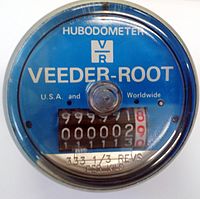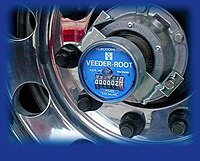| This article's tone or style may not reflect the encyclopedic tone used on Misplaced Pages. See Misplaced Pages's guide to writing better articles for suggestions. (December 2023) (Learn how and when to remove this message) |




A hubometer (from hub, center of a wheel; -ometer, measure of) or hubodometer, is a device mounted on the axle of any land vehicle to measure the distance traveled by a vehicle based on the rotations of the wheel hub.
The whole device rotates with the wheel, except for an eccentrically mounted weight on an internal shaft. The weight remains pointing downwards, and drives the counting mechanism as the body of the hubometer rotates around it.
Typical uses
Hubometers are essential for semi-trailers, serving as the primary method to track the accumulated distance traveled throughout the vehicle's lifespan. They find application in buses, trucks, or trailers, particularly those whose tires are provided to the vehicle operator through an independent company under a "price per thousand kilometers" contract. In this arrangement, the tire company installs the hubometer to obtain accurate measurements of the distance covered.
In New Zealand, hubodometers are used for the calculation of road user charges for HGVs powered by a fuel not taxed at source.
Historical data
At the Veeder Manufacturing Company in Hartford, Connecticut production of cyclometers, hubodometers, and other scientific tools was underway for contracts with the United States government. Designed by Curtis Veeder in 1895, the cyclometer measured the distance traveled by bicycles as Curtis was a bicycle enthusiast. He would later adapt the invention to measure distance traveled for automobiles, hubodometers, as well as hand-turned cyclometers for use by the US Weather Bureau. The Veeder Manufacturing Company would produce these tools for use by the US government during World War One. These devices would be placed on the wheel of an automobile to measure the distance traveled by counting the rotations of its wheels.
Curtis Veeder acquired the Root Company of Bristol in 1928 before retiring to form the Veeder-Root Corporation. It has remained in operation up to the present day. Utilizing his industrial riches, Veeder constructed an intricate stone mansion located on Elizabeth Street in Hartford. This mansion currently houses the Connecticut Museum of Culture and History.
See also
References
- "Road user charges (RUC) | Waka Kotahi NZ Transport Agency". Retrieved 2024-04-12.
- Road user charges handbook, ISSN 1176-9297
- "Veeder Counter". Smithsonian National Museum of American history - Behring Center.
- Muller, Mary (12 September 2014). "Yankee Ingenuity: Curtis Veeder, a Mechanical Genius and Shrewd Businessman". Connecticut History.org. Retrieved 28 January 2022.
- ^ "Hubodometers | Electronic & Mechanical Hubodometers |Veeder Root". Retrieved 2024-04-12.
- "VEEDER MANUFACTURING COMPANY". Central Connecticut State University Library. Digital History 511: Theory & Practice. Retrieved 2024-04-12.
- “Veeder’s Successful Development of the ‘Big Unit’ Market,” Printers’ Ink, vol. 103 #4, April 25, 1918, pp. 129–132, 137–138.
- Veeder Manufacturing Company, , no date, Hartford, Ct., Trade Literature, Smithsonian Institution Libraries.
This article about an automotive part or component is a stub. You can help Misplaced Pages by expanding it. |